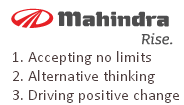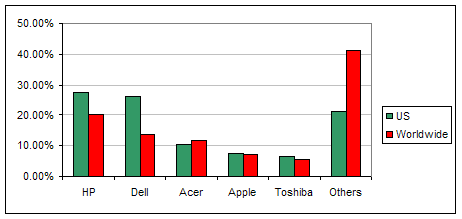Monday, May 2, 2011
Rise Mahindra Rise – Brand Makeover and Positioning
Re-branding Mahindra with a New tag-line
Around 13 years ago, Mahindra & Mahindra (M&M) defined its core purpose inspired by Akio Morita, founder of Sony Corporation. Its tag-line read – “Indians are second to none in the world.” While Sony Corporation represented Japan as the best in the world with its world-class products, M&M wanted to do the same with its products for India.

With this core purpose and global ambitions, M&M grew rapidly to a $7.1-billion automobiles-to-IT conglomerate since its founding in 1945. With businesses expanding to newer geographies (Mahindra Group has a presence in 79 countries around the world), 10 per cent of M&M’s workforce comprised of non-Indian employees. The tag-line no longer suited a global multinational company with customers all around the world. Mahindra chose to reposition itself based on employee, consumer and customer feedback and hired StrawberryFrog, a New York-based global advertising agency.
Around 13 years ago, Mahindra & Mahindra (M&M) defined its core purpose inspired by Akio Morita, founder of Sony Corporation. Its tag-line read – “Indians are second to none in the world.” While Sony Corporation represented Japan as the best in the world with its world-class products, M&M wanted to do the same with its products for India.

With this core purpose and global ambitions, M&M grew rapidly to a $7.1-billion automobiles-to-IT conglomerate since its founding in 1945. With businesses expanding to newer geographies (Mahindra Group has a presence in 79 countries around the world), 10 per cent of M&M’s workforce comprised of non-Indian employees. The tag-line no longer suited a global multinational company with customers all around the world. Mahindra chose to reposition itself based on employee, consumer and customer feedback and hired StrawberryFrog, a New York-based global advertising agency.
New branding called Rise
M&M had never communicated through a single brand umbrella across its segments such as aerospace, automotive, farm equipment, IT and logistics. The need for one brand voice spanning geographies was evident in capturing global markets. After a nine month search the company chose ‘Rise’ which the group’s vice chairman and managing director Anand Mahindra believes is not a word but a rallying cry that will give an opportunity to become tomorrow’s company. The word ‘Rise’ was chosen after customers around the world expressed a common desire to rise and to succeed.Spirit of ‘Rise’ – Three Brand Pillars
Rise is based on three brand pillars –- Accepting no limits
- Alternative thinking
- Driving positive change
Posted by
Manish kumar
How are successful innovators different ?
A recent study (400 companies) on global innovation by Booz & Company found that the most innovative companies (seven out of 10 top innovators) were not necessarily the biggest spenders on innovation. The top 10 innovators are:
- Apple
- 3M
- GE
- Toyota
- Microsoft
- P&G
- IBM
- Samsung
- Intel
Posted by
Manish kumar
Dell’s Supply Chain Management Strategy
Case Study Contents
- Introduction
- Dell – Company Overview
- Dell Products and Services
- Dell – Key Facts – Key Employees, Top Competitors, Revenues, Manufacturing Facilities
- Dell Timeline
- Dell – Business Segment Information
- Dell’s Evolving Supply Chain Strategy
- Typical Working of Dell’s Supply Chain
- Five key strategies in Dell’s successful Direct Model
- A supply chain with old technology is of little value
- Restructuring at Dell
- New Distribution Channels – Direct Model and Retail Strategy
- Integrating the Supply Chain
- Related Reading
- View sample pages of this case study
Case Study Abstract
The focus of this case study is the supply chain management practices of Dell. Dell has been following its unique ‘direct build-to-order’ sales model for more than 20 years. Customers can plan their own configuration and place orders directly with the company via the phone or its Web site. Over the years, Dell’s supply chain efficiencies and direct sales gave it a competitive advantage.Can Dell regain its market leader position from HP?
In 2006 however, Dell faced several problems. Many customers complained about long delays in supplies. Recall of Sony battery cells in its laptops brought undesirable media hype to the company. Increasing discontent of customers led to a slowdown in sales. Consequently, Dell lost its market leadership to Hewlett-Packard Co. (HP). Industry analysts felt that, with Dell’s competitors also improving their supply chains and matching Dell’s direct model, the company had been losing its competitive edge. Dell will have to bear additional costs with its foray into retail distribution thereby minimizing its cost advantage. Besides, profit margins of Dell will drop further since it will have to offer incentives to compete with HP in retail stores. Though Dell spruced up its product design and range but Apple is clearly far ahead of it. Many experts feel that such new initiatives will only distract Dell from its supply chain operations.
This case study covers the following issues:
- Examine and analyze Dell’s Direct model, its basic working, success and future challenges
- Typical Working of Dell’s Supply Chain and future supply chain challenges
- Highlights Dell’s evolving Supply Chain practices and strategy and steps being taken by it to recapture its lost market leader position
Case Snippets/Update

Dell’s market share in U.S. and Worldwide (in Q1 2009) compared to other top PC makers

Dell’s market share in U.S. and Worldwide (in Q1 2009) compared to other top PC makers
- In year 2010, PC sales are expected to rise 12.6 percent, according to research firm Gartner.
Posted by
Manish kumar
Operations and Supply Chain Management

Operations and Supply Chain Management
McGraw-Hill/Irwin | March 9, 2010 | ISBN-10: 0073525227 | 832 pages | File type: PDF | 9.79 mb
Operations and Supply Chain Management, as the title indicates, provides increased emphasis on supply chain management in the 13th Edition. The 13th Edition continues its market leading up-to-date coverage of service operations as well. The text includes solved examples and problems, enough cases for mbA courses to use without supplementing, and the industry leading technology support suite.
Download links:
http://depositfiles.com/files/0aam841w9
http://www.filesonic.com/file/36101751/0073525227pd.rar
Posted by
Manish kumar
Subscribe to:
Posts (Atom)